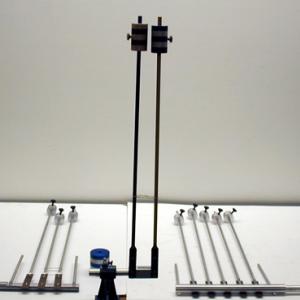College of Liberal Arts & Sciences
3A70.40 - Inverted Coupled Pendulum
Use the special table clamp and get the pendulum so it stands straight up and down. Gently start one of the pendulums in motion and within a short time the energy should be transferred to the other pendulum. Increase coupling, may be done connecting the two pendulums together with a rubber band. The closer the rubber band to the pendulum weights the greater the amount of coupling.
- Michael Thees, Sebastian Becker, Eva Rexigel, Nils Cullman, and Jochen Kuhn, "Coupled Pendulums on a Clothesline", TPT, Vol. 56, #6, Sept. 2018, p. 404.
- Heather Stephens, Austin Tam, and Michael Moloney, "Decay Times and Quality Factors for a Resonance Apparatus", TPT, Vol. 49, #7, Oct. 2011, p. 421.
- J. P. Sharpe and N. Sungar, "Supercritical Bifurcation in a Simple Mechanical System: An Undergraduate Experiment", AJP, Vol. 78, #5, May 2010, p. 520.
- Ross L. Spencer and Richard D. Robertson, "Mode Detuning in Systems of Weakly Coupled Oscillators", AJP, Vol. 69, #11, Nov. 2001, p. 1191.
- M. E. Oakes and Dean Creech, "Exposing Normal Modes", AJP, Vol. 45, #9, Sept. 1977, p. 882.
- Freier and Anderson, "Sa-1", A Demonstration Handbook For Physics.
- Freier and Anderson, "Mx-6", A Demonstration Handbook For Physics.
- David Kutliroff, "71, Resonance Demonstrations with Pendulums", 101 Classroom Demonstrations and Experiment For Teaching Physics, p. 156.
- Jearl Walker, "1.119, Coupled Pendulums", The Flying Circus of Physics Ed. 2, p. 58.
- Julien Clinton Sprott, "1.18, Coupled Pendulums", Physics Demonstrations, ISBN 0-299-21580-6, p. 52.
Disclaimer: These demonstrations are provided only for illustrative use by persons affiliated with The University of Iowa and only under the direction of a trained instructor or physicist. The University of Iowa is not responsible for demonstrations performed by those using their own equipment or who choose to use this reference material for their own purpose. The demonstrations included here are within the public domain and can be found in materials contained in libraries, bookstores, and through electronic sources. Performing all or any portion of any of these demonstrations, with or without revisions not depicted here entails inherent risks. These risks include, without limitation, bodily injury (and possibly death), including risks to health that may be temporary or permanent and that may exacerbate a pre-existing medical condition; and property loss or damage. Anyone performing any part of these demonstrations, even with revisions, knowingly and voluntarily assumes all risks associated with them.
